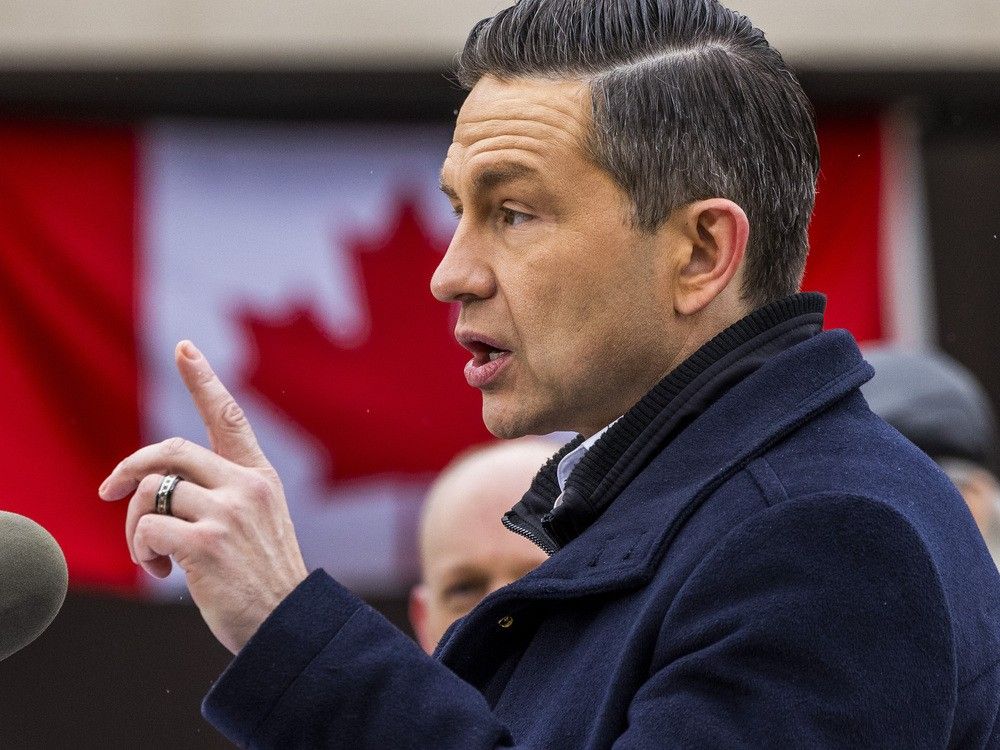As Canadians are set to mark the 43rd anniversary of the Charter of Rights and Freedoms on Thursday, Pierre Poilievre promised this week that his government would invoke a never-before-used section at the federal level to keep mass murderers in prison until death.
The Conservative leader first
pitched the idea of utilizing Section 33
last year, but his new pledge comes as Canadians are about to head to the polls with crime and safety still a major issue, even in the shadow of Donald Trump’s tariffs and the ongoing affordability crisis.
However, unlike those issues and others influencing decisions on April 28, it’s likely that for many voters, the complexity of the notwithstanding clause may require added context as a campaign topic.
Here’s what you need to know.
What is the clause, and how was it meant to work?
Without delving into an eye-glazing history of the
’s 1982 signing and proclamation, the notwithstanding clause — sometimes called override power — is a “legislative instrument” added at the behest of the provinces to allow “provincial legislatures or the federal department to declare that an Act … shall operate notwithstanding certain provisions in the Charter of Freedoms,” explained Dave Snow, University of Guelph political science associate professor, whose areas of focus include criminal justice and constitutional law.
“To be frank, most of the important rights — your fundamental freedoms in Section 2, your legal rights in Sections 7 through 14 and your equality rights in Section 15.”

Sections dealing with language, mobility, and democratic rights are untouchable.
The clause can only be applied for five years at a time, after which government must vote to re-enact the law. With mandated four-year election cycles, this allows the public to weigh in on government’s use of power.
When and where has the clause been used before in Canada?
It’s never been used at the federal level, though members of parliament have brought forward private bills, none of which have passed.
Last year, Bloc Quebecois MP MP Denis Trudel put forth a bill that would effectively put into law the reasonable time limits established by the Supreme Court in its 2016 Jordan decision by
invoking the clause to create an exemption
to those deadlines to primary designated offences — the most violent and serious crimes under Canada’s Criminal Code.
Provincially, however, it’s been used 27 times to varying degrees of success, mostly by Quebec (17), the chief critic of the Charter and the only province other than Saskatchewan to successfully use the clause for the first 15 years of its existence.
The most famous use of the clause, Snow said, was in 1988 when Quebec invoked it to circumvent the Supreme Court’s ruling in the
After that, “there’s this big gap between 1989 and 2018 when only one province outside of Quebec passes a law invoking” the clause, Snow pointed out.
That was Alberta, which successfully used it in a 2000 bill to limit marriage to a man and a woman, only to have it rendered useless because matrimony is under Ottawa’s constitutional purview.
In 2018,
Saskatchewan became the first province to use it since 2005
, though it was later deemed unnecessary, after which Quebec employed it again, and Ontario did so twice. Saskatchewan was the last to see it succeed on a law surrounding parental consent with regards to pronouns or names their children use at school.
“The polling data I’ve seen shows that, as an abstract thing, Canadians tend to be more opposed to (the notwithstanding clause) than in favour,” Snow told National Post. On
, however, he said “most polling showed that more people favoured the use of it than did not, not just in Saskatchewan, but everywhere in Canada.”
Still, Snow insisted that it’s unexpectedly become a “Quebec thing” in recent years as it’s been used to promote French language and culture.

What does the clause have to do with mass murderers?
For first-degree murder in Canada, there is a mandatory 25-year sentence before parole eligibility.
In 2011, the Stephen Harper-led government brought in
giving judges the power to apply consecutive life sentences for individuals found guilty of multiple murders.
Two likely come to mind for Canadians: 2014
New Brunswick Mountie-murderer Justin Bourque
and Alexandre Bissonnette, who massacred six Muslim people at a Quebec mosque in 2017.
Bourque got 75 years before parole, while Bissonnette was dealt 40.
However, both sentences were reduced to the standard
, and the Harper-era provision was neutered following the
Supreme Court’s unanimous 2022 ruling
against the Crown’s appeal to make Bissonnette wait 50 years for parole eligibility.
Multiple murderer Alexandre Bissonnette ruled eligible for parole after 25 years — not 40
“Under this provision, a court has the power to sentence an offender to imprisonment for life without a realistic possibility of parole for 50, 75 or even 150 years,” wrote the nine judges, led by Justice Richard Wagner.
“In other words, in the context of multiple first-degree murders, all offenders to whom this provision applies are doomed to spend the rest of their lives behind bars, and the sentences of some offenders may even exceed human life expectancy. Not only do such punishments bring the administration of justice into disrepute, but they are cruel and unusual by nature.”
Toronto criminal defence lawyer Danielle Robitaille, who served as an intervenor on behalf of the B.C. Civil Liberties Association in the case, said the decision, which she heralds as “eloquent and moving,” firmly established that everyone — “even the vilest criminal” — is owed a shot at rehabilitation within Canada’s justice system.
“What the court found is that what’s important for the system in a life sentence is that you don’t extinguish the possibility of parole, even though everyone concedes that in these cases of multiple murder, it’s extremely remote that parole would ever be granted and we’ve seen that with our most notorious historical cases of multiple murders,” she told National Post.

Snow countered, saying the decision made assumptions about Canadians’ feelings regarding stacked sentences without any evidence of those feelings.
“It’s in these instances where I think it’s perfectly appropriate, whether I agree with the policy or not, for Parliament to say ‘we disagree with this interpretation of rights, we disagree with the way the Supreme Court has determined what both cruel and unusual punishment is, and what a reasonable limit on that is, and we’re going to offer an alternative interpretation.’”
How are Pierre Poilievre and the Conservatives proposing to use the clause?
Poilievre, who cited both Bourque and Bissonnette when making the campaign commitment, said a Tory-led parliament would use the notwithstanding clause to restore the sentencing provision.
“The worst mass murderers should never be allowed back on our streets,”
. “For them, a life sentence should mean what it says: a life sentence. They should only come out in a box.”
The Conservatives say the victims’ Charter rights and those of their families forced to testify and relive the trauma at mandatory parole hearings, along with the rights of law-abiding Canadians, are at risk from murderers potentially released.
In their view, a murderer’s punishment should be proportional to the number of people they killed.
“I will use the Charter to protect the Charter,” said Poilievre, who also vowed to only use Section 33 to “fight crime.”
On the campaign trail, NDP Leader Jagmeet Singh said he was already worried about the provinces using the clause “more and more,” while Liberal leader Mark Carney called it a “very dangerous step” that could lead to further “politicization” of criminal justice.
“We have a Charter of Rights and fundamental freedoms in this country, and it’s the responsibility, in my view, of the prime minister of the government of Canada to defend that Charter, those fundamental rights.”
Because few, if any, would stand up for the rights of a mass murderer like Bissonnette, Robitaille recognizes most voters will feel strongly about the topic. But she’s critical of the clause being used to stoke the already “inflamed passions of the Canadian public.”
“Because it’s precisely in this context that the constitutional balance is set up in a way that the Court is responsible for safeguarding and protecting the most outcast, the most vulnerable, protecting the minority against the rage of the majority.
“To use and wield the section to usurp that protection, I think, is irresponsible and distasteful.”
Her biggest fear is seeing Canada’s justice system start to resemble that of the United States, where prisoners are sometimes given sentences longer than any human could imagine living.
Snow disagreed, downplaying any notion of long-standing rights being infringed and said it can be good for a democracy to have elected representatives disagree with the courts on this particular issue.
Politicians leaving everything to the courts, he said, sidesteps a degree of responsibility on topics on which Canadians should be engaged and informed in the event the court gets it wrong.
“I think we’re a healthier country when we at least debate the merits of having some involvement from our democratically elected representatives on these contentious issues of rights, on which I should say reasonable people disagree, reasonable judges disagree, and which in this instance is of a very new interpretation by the Supreme Court of Canada just three years old.”
Our website is the place for the latest breaking news, exclusive scoops, longreads and provocative commentary. Please bookmark nationalpost.com and sign up for our daily newsletter, Posted, here.






